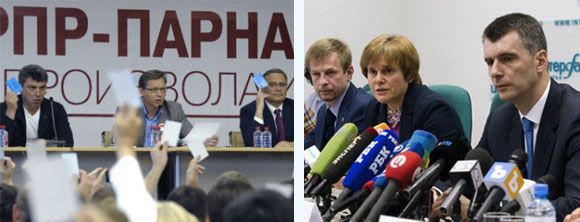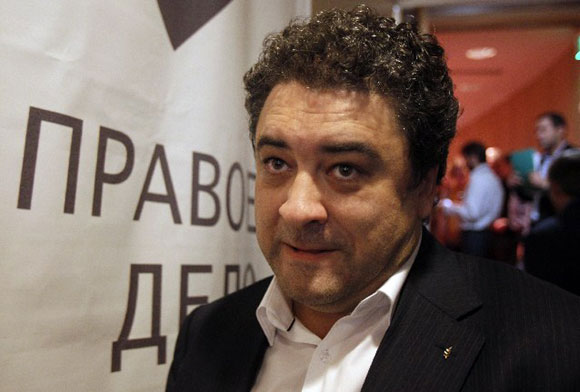The first hundred days of Putin's “new” presidency have been marked by a severe tightening of the screws. Laws on public rallies, defamation, and “foreign agents,” hastily rubberstamped by the Federal Assembly and signed by the President, further restrict civil society’s ability to function. Yet, a significant concession forced on the Kremlin by its opponents at the height of the December protests – liberalized rules for registering political parties – continues to stand, and may even come to fruition this fall. IMR first addressed the resurgence of Russia's opposition parties in Olga Khvostunova's article "Party Renaissance." Now, historian and political commentator, Vladimir V. Kara-Murza, discusses Russia’s new multiparty system.

Last December, for the first time after more than a decade in power, Vladimir Putin’s regime was forced to compromise with the opposition. Following a 100,000-strong protest rally in Bolotnaya Square (Moscow’s largest demonstration since the 1991 democratic revolution), the authorities announced “political reforms.” In his last annual state-of-the-nation address, Russia’s figurehead president, Dmitri Medvedev, promised to reinstate the direct gubernatorial elections which had been abolished in 2004 (and which, according to the Kremlin’s plans, were not supposed to return even “in a hundred years”), ease registration requirements for presidential candidates, and simplify the rules for establishing political parties.
Along with the mass media, the judiciary, and the rights of regions, Russia’s party system and electoral system have been almost completely gutted under Putin. In 2011 in Russia, the so-called multiparty system looked very much like that of the East Germany, where Putin once operated as a KGB officer. Unlike most Warsaw Pact countries, East Germany was never officially a one-party state: the ruling Socialist Unity Party (SED) was joined in “parliament” by the representatives from other registered groups, including the Christian Democratic Union (CDU), the Liberal Democratic Party of Germany, the National Democratic Party of Germany, and the Democratic Farmers’ Party of Germany. In fact, SED deputies never controlled a majority of seats in the People’s Chamber, which was for several years chaired by CDU member Gerald Götting. Needless to say, the permitted alternative parties fully supported the government’s socialist course.
In Russia, the seven parties allowed to take part in the 2011 parliamentary election were, to a greater or lesser extent, controlled by the Kremlin. The exception, to some degree, was the liberal Yabloko party, whose poll monitors encountered the heaviest resistance from authorities. In comparison to 2011, 28 parties and blocs participated in the 1999 parliamentary election. In 2003, the figure was 22. By 2007 it was down to 11 parties (by this time, electoral blocs had been banned.)
The new law allowed the Ministry of Justice to deny registration to a party if a single mistake was found in its membership lists. Minimum membership requirements of 50,000, then 45,000, then 40,000 people gave authorities ample opportunity to remove undesired organizations from the political scene without an independent judiciary for the parties to turn to.
Between 2007 and 2011, the Ministry of Justice denied registration to eight opposition parties, from Eduard Limonov’s left-wing nationalist The Other Russia to the liberal (in the European, not the American sense) center-right People’s Freedom Party (PARNAS), led by Boris Nemtsov, Mikhail Kasyanov, and Vladimir Ryzhkov. The absence of registration automatically meant the absence of ballot access. (In this regard, the laws of Czarist Russia were significantly more democratic: the Interior Ministry’s refusal to register the charter of the Constitutional Democratic Party–People’s Freedom Party [informally, the Kadets] until the 1917 February Revolution did not prevent the Kadets from nominating and electing candidates to all four State Dumas between 1906 and 1917.) Given that up to 18 percent of Russians, according to a Levada Center poll, were considering voting for PARNAS, the purging of the political field placed a question mark over the legitimacy of the 2011 election long before mass fraud during voting and the vote count was uncovered.
The principal demands on the Kremlin from the tens of thousands of protesters in December were to release political prisoners, hold new elections to the State Duma, and register opposition parties. Of the several dozen political prisoners held, only one – Sergei Mokhnatkin – has been released. (Since, according to the recent court decision, Platon Lebedev is supposed to be let out of prison in February or March 2013, much earlier than expected, he could be added to this short list, even though it might be considered a stretch.)
For now, the demand for new elections is still being ignored by the authorities. The legalization of opposition parties is, therefore, the only aim of the December protests that can be counted as fulfilled. The new federal law that took effect in April lowered the minimum membership requirement for parties from 40,000 to 500, and reduced (although didn't completely eliminate) opportunities for the Ministry of Justice to mount legal obstacles to registration. At the same time, the Russian authorities have complied with last year’s ruling by the European Court of Human Rights that found the refusal to register Vladimir Ryzhkov’s Republican Party to be unlawful.
As of today, the official registry of the Ministry of Justice lists 37 political parties that have the right to participate in local, regional, and federal elections. Applications from an additional 197 parties are currently under consideration. Having been forced to make a political concession over the registration of parties, the regime has attempted to neutralize its effect using the tactic of deluge. According to Kremlin operatives, the creation of dozens of new parties will confuse voters, split the opposition vote, and hand the ruling party a victory even with significantly reduced support. It is believed that several new parties have been established with the participation of well-known Kremlin shill Andrei Bogdanov, who had previously seized control of the Democratic Party of Russia from Mikhail Kasyanov, and of the Right Cause party from Mikhail Prokhorov. Bodganov himself has stated that he is “helping” some thirty new parties. The Russian Freedom Party, the Conservative Republican Party, the Left Front, For Justice, and the Communists of Russia are just some of the obvious spoilers directed against existing political organizations.
It is unlikely, however, that this ingenious plan will succeed. Most Russian voters will easily distinguish between the real parties and the decoys. It is worth recalling that every Kremlin attempt to create phony "liberal" projects – from Civic Force to Right Cause – has ended in failure. Pro-democracy voters invariably sense the falsehood. It is doubtful that a supporter of the democratic alternative to Putin’s regime would confuse Boris Nemtsov’s People’s Freedom Party with the Constitutional Democratic Party led by a certain Alexei Lushnikov – a former member of Bodganov’s Democratic Party. (In fact, the Kremlin’s only successful ruse was implemented against the left-wing nationalist flank. In 2003, the Motherland bloc – led by Putin’s current adviser Sergei Glazyev and current Deputy Prime Minister Dmitry Rogozin – which was hastily set up and trumpeted on state-run television, took nearly half the votes from the Communist Party).
As for the notion that long ballot paper would confuse voters, it is not only insulting but also baseless. In 1995, when 43 parties and blocs competed in the Russian parliamentary election, all the major political forces – communists (CPRF), liberals (Yabloko), nationalists (LDPR), and centrists (Our Home – Russia) – gained representation in the State Duma. Apropos of this, 62 parties took part in the Spanish general election of 2011.

Well-known Kremlin shill, champion Russian party-builder, and head of the Grand [Masonic] Lodge of Russia, Andrei Bogdanov
Perhaps the only danger that the Russian protest movement should watch out for is a fragmentation of its own forces. Whereas participants in the street rallies can be grouped into three political camps, liberals, nationalists, and leftists (nuanced differences aside), there will doubtless be many more parties aspiring to represent their interests. Already at least three new parties are being established in the liberal democratic wing – and that on top of the already existing Yabloko. (According to pollsters, this wing dominated the December protests: a poll by the Levada Center showed that 69 percent of those who participated in the December 24 rally on Sakharov Avenue described their views as “democratic” or “liberal.”)
On August 2, the Ministry of Justice officially registered the unified Republican Party of Russia–People’s Freedom Party (RPR-PARNAS), which is led by Nemtsov, Kasyanov, and Ryzhkov and which positions itself as the Bolotnaya Square and Sakharov Avenue protesters’ principal advocate. Its key demands include the release of political prisoners, the democratization of electoral laws, a comprehensive constitutional reform (limiting presidential power and expanding parliamentary authority), the dismantling of state control over the media, elections for magistrate judges, the promotion of economic competition, and an investigation into the corruption of senior government officials. Nemtsov called RPR-PARNAS “a party of the cities and of the educated.”
The same electorate is being sought by the already registered Civic Platform party established by entrepreneur and former presidential candidate Mikhail Prokhorov (though Prokhorov himself has refused not only to lead the party, but even to join it); as well as by the December 5 Party [the day post-election protests began in 2011], that was set up by a group of civic activists including Denis Bilunov, Natalia Pelevine, and Sergei Davidis, and which emphasizes its “horizontal” and decentralized character.
All these parties, including Yabloko, are natural allies and are indicating readiness to cooperate with each other. Despite the fact that electoral blocs are still prohibited (the “Medvedev reforms” changed nothing in this respect), there are ways to form de facto coalitions: for instance, by including members who temporarily resign from one party in another party’s electoral list.
One more party associated with the protest movement (even though this party's ideology is not yet clear) is the People’s Alliance, which is currently preparing for its inaugural congress. The Russian press has already dubbed it Alexei Navalny’s party, though the anticorruption blogger himself does not intend to join any political groups. Vladimir Ashurkov, Navalny’s colleague and a co-founder of the People’s Alliance, has said that the party will not “attach any ideological labels,” and intends to “consolidate … all people of good will.”
In spite of the limited (and imitative) nature of the “Medvedev reforms,” and of the Kremlin’s attempts to turn the multi-party system into a farce, Russia’s independent opposition has – for the first time in many years, and thanks to public pressure – gained access to the ballot. Recent victories by opposition candidates in the mayoral elections in Chernogolovka, Tolyatti, and Yaroslavl, and the relative success (30 percent of seats) in the municipal elections in Moscow have shown that even in Putin’s electoral system, with its administrative pressure, ballot stuffing, and rigged vote count, the regime’s resources are not endless. The opposition now has an additional avenue to put pressure on the authorities: not only through mass rallies, which remain the principal tool for civic mobilization, but also through the ballot box. With effective organization and with greater unification in their fight against the Kremlin, political parties can provide a platform for launching a new generation of opposition leaders, especially in the provinces. The opposition's first test will come on October 14, when local and regional elections are to be held across Russia.

